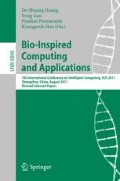Abstract
In this paper, we propose a saturation binary neuron model and use it to construct a Hopfield-type neural network called saturation binary neural network to solve the bipartite sub-graph problem. A large number of instances have been simulated to verify the proposed algorithm, with the simulation result showing that our algorithm finds the solution quality is superior to the compared algorithms.
Access this chapter
Tax calculation will be finalised at checkout
Purchases are for personal use only
Preview
Unable to display preview. Download preview PDF.
References
Garey, M.R., Johnson, D.S., Stockmeyer, L.J.: Some simplified NP-complete graph problem. Theor. Comput. Sci., 237–267 (1976)
Karp, R.M.: Reducibility among combinatorial problems. In: Complexity of Computer Computations, pp. 85–104. Plenum, New York (1972)
Even, S., Shiloach, Y.: NP-completeness of several arrangement problems. Technical Report 43, Department of computer Science, Technion, Haifa Israel (1975)
Bondy, J.A., Locke, S.C.: Largest bipartite subgraph in triangle-free graphs with maximum degree three. J. Graph Theory, 477–504 (1986)
Grotscheland, M., Pulleyblank, W.R.: Weakly bipartite graphs and the max-cut problem. Oper. Res. Lett., 23–27 (1981)
Barahona, F.: On some weakly bipartite graph. Oper. Res. Lett. 2(5), 239–242 (1983)
Hopfield, J.J.: Neural networks and physical systems with emergent collective computational abilities. Proc. Nat. Acad. Sci. U.S. 79, 2554–2558 (1982)
Hopfield, J.J.: Neurons with graded response have collective computation properties like those of two-state neurons. Proc. Nat. Acad. Sci. U.S. 81, 3088–3092 (1982)
Hopfield, J.J., Tank, D.W.: ’Neural’ computation of decisions in optimization problems. Bio. Cybern. 52, 141–152 (1985)
Hopfield, J.J., Tank, D.W.: Simple ’Neural’ optimization networks: An a/d converter, signal decision circuit, and a linear programming circuit. IEEE Trans. Circuits Syst. 33(5), 533–541 (1986)
Hopfield, J.J., Tank, D.W.: Computing with neural circuits: A model. Science 233, 625–633 (1986)
Lee, K.C., Funabiki, N., Takefuji, Y.: A parallel improvement algorithm for the bipartite subgraph problem. IEEE Trans. Neural Networks 3(1), 139–145 (1992)
Garey, M.R., Johnson, D.S.: Computers and Intractability: a Guide to the Theory of NP-Completeness. W.H. Freeman, New York (1979)
Ackley, D.H., Hinton, G.E., Sejnowski, T.J.: A learning algorithm for Boltzman Machines. Cognitive Science 9, 147–169 (1985)
McCulloch, W.S., Pitts, W.H.: A logical calculus of ideas immanent in nervous activity. Bull. Math. Biophys 5, 115–133 (1943)
Takefuji, Y., Lee, K.C.: An artificial hysteresis binary neuron: A model suppressing the oscillatory behaviors of neural dynamics. Biol. Cybern. 64, 353–356 (1991)
Wang, R.L., Tang, Z., Cao, Q.P.: A Hopfield Network Learning Method for Bipartite Subgraph Problem. IEEE Trans. Neural Networks 15(6), 1458–1465 (2004)
Johnson, D.S., Aragon, C.R., McGeoch, L.A., Schevon, C.: Optimization by simulated annealing: An experimental evaluation; Part 1, graph partitioning. Operations Research 37(6), 865–892 (1989)
Author information
Authors and Affiliations
Editor information
Editors and Affiliations
Rights and permissions
Copyright information
© 2012 Springer-Verlag Berlin Heidelberg
About this paper
Cite this paper
Zhang, C., Zhao, LQ., Wang, RL. (2012). A Saturation Binary Neural Network for Bipartite Subgraph Problem. In: Huang, DS., Gan, Y., Premaratne, P., Han, K. (eds) Bio-Inspired Computing and Applications. ICIC 2011. Lecture Notes in Computer Science(), vol 6840. Springer, Berlin, Heidelberg. https://doi.org/10.1007/978-3-642-24553-4_10
Download citation
DOI: https://doi.org/10.1007/978-3-642-24553-4_10
Publisher Name: Springer, Berlin, Heidelberg
Print ISBN: 978-3-642-24552-7
Online ISBN: 978-3-642-24553-4
eBook Packages: Computer ScienceComputer Science (R0)

